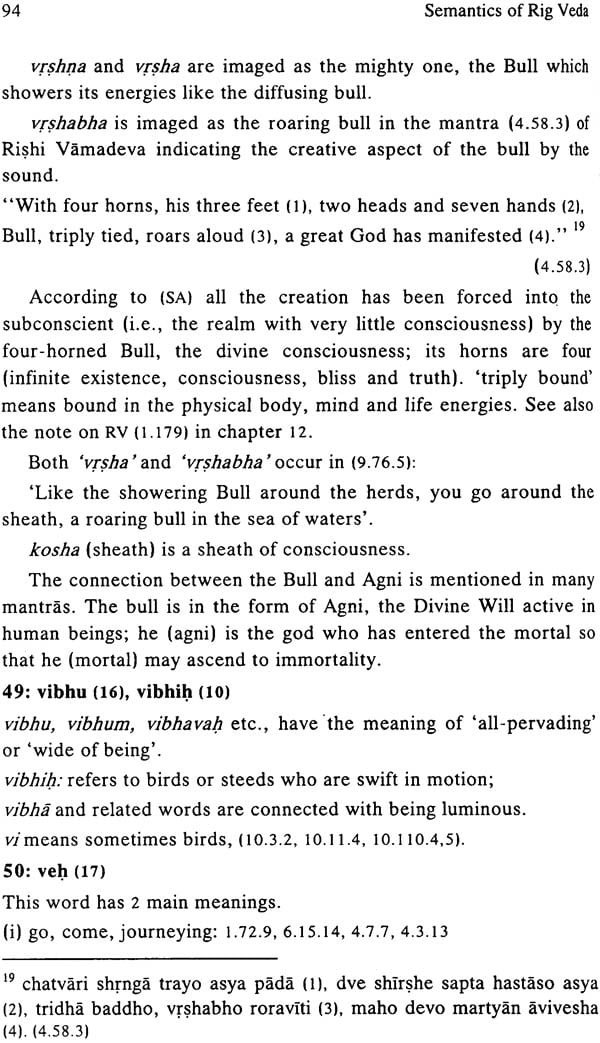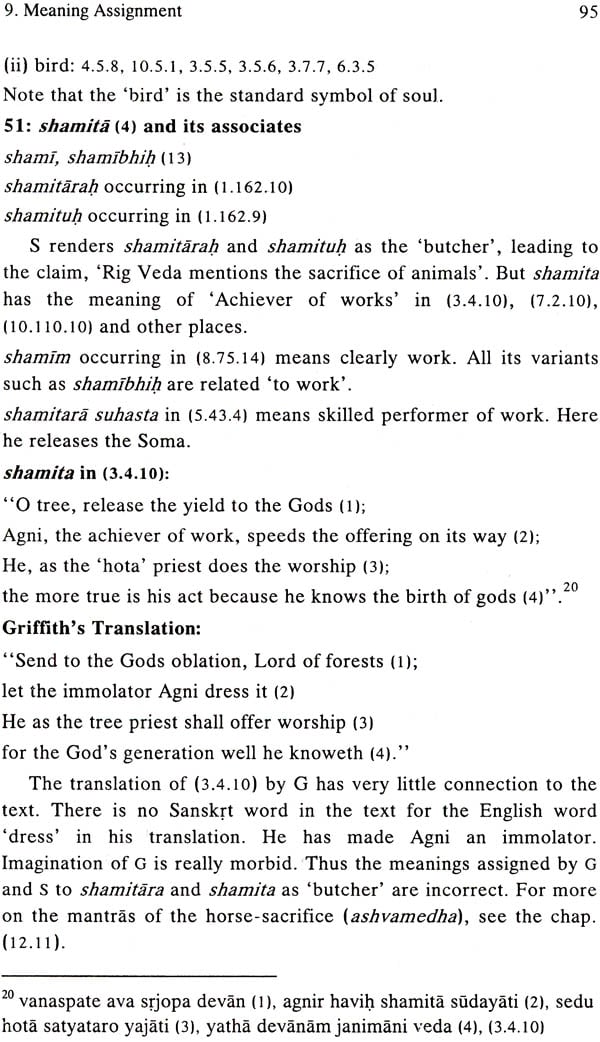
Semantics of Rig Veda
Book Specification
| Item Code: | NAE895 |
| Author: | R.L. Kashyap |
| Publisher: | Sri Aurobindo Kapali Sastry Institute of Vedic Culture |
| Language: | English |
| Edition: | 2017 |
| ISBN: | 8179940497 |
| Pages: | 197 |
| Cover: | Hardcover |
| Other Details | 8.5 inch X 5.5 inch |
| Weight | 200 gm |
Book Description
Dr. R.L. Kashyap is Professor Emeritus of Electrical and Computer Engineering at Purdue University, Lafayette, Indian in USA. He had his Master’s degree from Indian Institute of Science, Bangalore and obtained Ph. D from Harvard University. He is the recipient of many International awards. Recently he has received ‘Vedanga Vidvan’ award instituted by Maharshi Sandipani Vedavidya Pratishthan (Ujjain), and autonomous body of HRD, Govt. of India and ‘Jnana Keerti’ award instituted by Harsha Kriya Foundations, Bangalore.
He has authored more than 350 research articles of which 220 are published in scholarly journals and the rest were presented at conferences. He has guided above 50 doctoral students.
He has written extensively on Veda. Some of his widely read books on Veda are : ‘Why Read Rig Veda’. ‘Secrets of Atharva Veda’, ‘Essentials of Yajur Veda’, ‘Work, Enjoyment & Progress’ Divinizing Life’ etc.
He is the Honorary Director & Trustee of Sri Aurobindo Kapali Sastry Institute of Vedic Culture, Bangalore.
Syntax and Semantics are the two wings of a language. Syntax gives the set of rules to construct sentences which are legal in the language. Semantics is the study of the meanings of words and phrases. Every legal sentence need not be meaningful. For instance the sentence, ‘the mantra-chant smashed a hill’ is legally correct, but makes no sense. As discussed in the appendix, the Sanskrt of Veda mantras is substantially different from the classical Sanskrt of Veda mantras is substantially different from the classical Sanskrt. The grammar of the Sanskrt of Veda mantras is relatively simple consisting of short phrases and short sentences having less than 4 or 5 words. In the present book, we discuss the semanticsof Rig Veda, i.e., how to understand the meaning of Rig Veda mantras.
This book is designed to help the beginners in Vedic studies to understand the meanings of the individual words and the phrases in Veda mantras.
This book is our response to several requests for an introductory book on understanding the Veda, the meaning of words, the symbolism of phrases etc. They were very happy to read the compact books published by SAKSI. These books give the text, translation and explanation of some mantras relevant for the topic of the respective book. But they are in need of a book which gives an integral and expository view of the knowledge presented in our compact books and the related knowledge in some suktas not discussed in these books.
The chapters three to nine deal with the individual words. A beginner needs to become familiar with at least 500 words. The words are divided into 10 groups, each group dealing with one topic. For instance, the group A1 given in chap. 5 gives over sixty words dealing with mental operations and consciousness. We introduce the idea of keywords i.e., those which occur in many mantras, say at least 100. Clearly if we make a mistakes in 100 places. In chapter 9 we discuss 60 families of words, each family consisting of words which sound similar but are different in meaning. We refer frequently to the double meaning of words, one is its surface meaning, the other is its deep meaning.
In chapter 10, we discuss the symbolism of the phrases, the symbolism of events and that of yajna. Because of the double meaning of the words, every phrase has an outward meaning and an inner deeper meaning. The words cow, ghee, horse etc., symbolise psychological powers.
The chapter 11 discusses the word gau in great detail. We consider all the 115 mantras in which it occurs in the entire first ashtaka. The meaning ‘Ray of Knowledge’ is fixed for it. After reading this chapter-2 years ago, the great Veda scholars Late Prof. S.K. Ramachandra Rao declared that this material should be published in a book form. He said that most commentators quote one or two mantras in fixing the meaning of a word. Here I had discussed in some detail about 150 mantras in which gau or its case variants occur in various contexts.
In chapter 12, we discuss the overall meaning of certain suktas based on all the mantras in them. Detailed answers are given to a number of questions raised by persons who have certain preconceived notions on Veda. For instance, does Rig Veda allow freedom of enquiry? What is the relation between the Upanishad and Veda? Is there mention of the conception of the one in Veda? Is there mention of the conception of the One in Veda? See the table of contents for the questions posed. This book has several appendices. The third appendix deals with simplicity of the grammar of Veda mantras. This appendix also points out that the most of the complexities in the Sanskrt grammar are not needed for understanding the deeper meaning of Veda mantras.
The genesis of this book can be traced to the period about 30 years ago when I began my details study of Veda in the United States based on the two books of Sri Aurobindo which give summary translations of many mantras. Later I had the help of the Sanskrt book, ‘Siddanjana’, the magnum opus of Sri Kapali Sastry and the books by Sri M.P. Pandit (1918-1993), such as ‘They Key to Vedic Symbolism’ which gives extensive abstracts from Sri Aurobindo’s works the nature of gods and the related words. About 15 years ago, I came across the book “Sri Aurobindo’s Glossary” by A.B. Purani which gives the meaning of every Sanskrt word in many of the mantras for which Sri Aurobindo has given his summary translations. During these years I found that the Sanskrit English dictionaries are of little help to the beginning students in the Veda with a limited vocabulary. The dictionary gives many meanings for the same word; most of these meanings are not of much use in understanding the Vedic words. Hence the utility of a book such as, ‘Sri Aurobindo’s Glossary’ can hardly be underestimated.
A very short version of the present book was included in the SAKSI book ‘Secrets of Rig Veda’, to help the reader to understand the symbolism. The only thing common between this early version and the present book is the chapter 11 of this book. Otherwise the subject matter in the present book is wider in scope and in detail as compared to the earlier version. Thanks to Sri T.B. Lakshmana Rao and Smt. Ambuja for reading the manuscript. Thanks for the staff of SAKSI for patiently typing the numerous drafts of this book.
| (i) | Note to the Readers | v |
| (ii) | Abbreviation | vii |
| (iii) | Transliteration Scheme | viii |
| 1 | The Basic Question and Examples | 1 |
| 2 | Message of Rig Veda | 16 |
| 3 | Preliminary Study of Words | 19 |
| 4 | Thee-structure and the 80-20 Rule | 24 |
| 5 | Words-groups | 32 |
| 6 | Gods and Demons | 48 |
| 7 | Some Genenral Principles for Meaning Assignment | 59 |
| 8 | Procedure | 63 |
| 9 | Meaning Assignments: 60 Illustrations | 68 |
| 10 | Symbolism in the Veda: Sri Aurobindo's Insights | 101 |
| 11 | Study of all the Mantras with the word gau | 116 |
| 12 | Insight on Some Suktas | 133 |
| 13 | Conclusions | 155 |
| Appendices | 157 | |
| Indices | 176 | |







